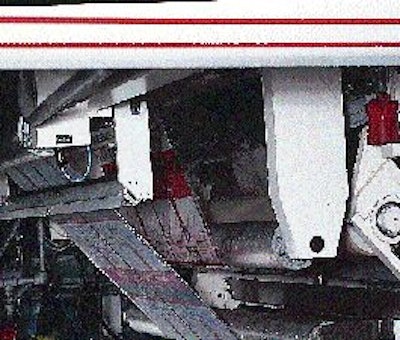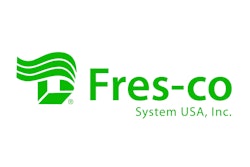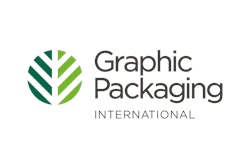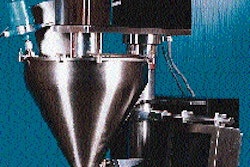If it takes money to make money, Graphic Packaging should remain in the black. The flexible packaging converter has invested $9 million in an unusual new press and expanded facilities at its Franklin, OH, plant to gain a competitive edge. Its new 10-station Rotoflexo 3000 press, from Rotomec America (West Hartford, CT), is the first of its kind in use in the U.S. It was custom engineered by Rotomec and Graphic Packaging personnel at Rotomec SpA in San Giorgio, Monferrato, Italy. Following months of assembly and testing, production began last February. What makes the press so unusual? "We can in-line laminate, apply specialty coatings with 100-percent or in-register spot coverage, and combine rotogravure and flexographic printing in one pass with consistent quality control," says Donald James, marketing manager for Wayne, PA-based GP's Flexible Packaging Div. All this at speeds exceeding 1ꯠ'/min. Each printing station on the Rotoflexo includes a trolley system equipped with integral ink feed and recovery to permit preparation of inks, trays and cylinders off-line while another job is running. Graphic Packaging can prepare the trolley with cylinders for either flexographic or gravure printing. The push of a button on a station control module activates an automatic loading station. Pneumatic arms extend to the trolley, then retract to position the trolley to the frame. Locking devices on the machine's gear side engage, securing the cylinder. This automatic process speeds clean-up and changeover times. First application To make room for the Rotoflexo 3000, GP expanded the Franklin plant by 35ꯠ sq'. The new space is used primarily to warehouse raw materials, which were moved from an existing 7괌-sq'-room that now houses the new 129'-long press. The first commercial run on the Rotoflexo was for a structure that's made into a bag for whole bean coffee sold under the Spotlight Whole Bean Coffee brand. Spotlight is filled into bags by Pontiac Foods, a Columbia, SC, private-label manufacturer for Cincinnati, OH-based Kroger Co. Spotlight retails in 13-, 26- and 39-oz bags at some 1괌 Kroger grocery stores within the U.S. The smallest size is available in Regular Roast, Dark Roast and Decaffeinated versions; the two larger sizes in Regular. "Graphic Packaging supplies us with all our flexible material for coffee products," says Joe Girone, general manager for Pontiac Foods. "The material is a high-barrier structure that enables us to get 180 days' shelf life. The bags are filled and nitrogen flushed on two new Goglio GL-14/S vertical form/fill/seal machines we added in March." The Italian equipment is represented in the U.S. by Fres-Co System USA (Telford, PA). The machines heat-seal a plastic degassing valve on the inside layer of the material. The valve, along with two tiny slits that are cut into the front of the bag structure where the valve is located, permit the escape of carbon dioxide that's released by the fresh coffee beans. The slits are cleverly hidden within a graphic element that shows a steaming hot cup of coffee on a saucer. The structure is designed to release the CO2 while also blocking entrance of larger oxygen molecules. This helps lengthen coffee shelf life. A tin-tie closure completes the package. "Prior to adding the new machines we ran Spotlight on older equipment that used mandrels and scales," he recalls. "We used an inner glassine liner and a paper wrap for the structure, which was not hermetically sealed, so we only had a 45-day shelf life." To lengthen shelf life, the packager invested in the new machinery and bag materials. "We're very happy with the film structure that Graphic Packaging converts on the Rotomec machine," says Girone. "The structure has increased our product freshness. We plan to use the added shelf life as a marketing advantage." Multi-ply structure The thickness for all three coffee bag sizes measures between 5.5 and 6 mils. For the 13- and 26-oz sizes, the structure includes a 48-ga outer layer of polyester/ink/tie layer/48-ga polyester/tie/0.00035 foil/tie/3-mil proprietary easy-to-peel sealant. The 39-oz size structure differs in that it uses a 3-mil linear low-density polyethylene sealant layer that provides additional hot-tack and strength characteristics to help withstand the heavy fill of coffee beans. What is especially different about the structures is the way they are built. The 13- and 26-oz varieties begin on the Rotoflexo. A roll of unprinted 48-ga polyester is automatically lifted into place on a power unwind that holds two webs, permitting flying splices. A web guiding system helps maintain tension as the film is pulled from the rewind. The film continues through a series of idler rollers to the first of the 10 stations, where it is corona treated. The film bypasses the second station; it's used to preheat other film structures. The corona-treated film is then reverse-printed via gravure at six stations. The order of ink laydown and sequence of stations is determined by the color combination for the different bag graphics, as is ink set-up. After each color is applied, the web ascends to an overhead dryer, then descends to the next print station. The 13-oz Spotlight bag structure is printed four-up across a 50.5" web; the 26-oz three-up across a 47.5" web. The press accommodates webs to 56" wide. At either station 9 or 10, the printed Spotlight film is dry-bond adhesive-laminated to another 48-ga layer of polyester. The printed/laminated web rewinds automatically. It is then transferred to a Black Clawson (Fulton, NY) coater/laminator at Franklin. In a single pass, the two-ply material prepared on the Rotoflexo is adhesive-laminated to aluminum foil, then coextrusion-mounted to a proprietary peelable sealant layer. The 39-oz structure begins on the Black Clawson with the unprinted layer of polyester adhesive-laminated to the foil. Next, an adhesive/polyethylene coextrusion tie layer is used to marry the foil to the LLDPE. This structure is then brought to the Rotoflexo where it is adhesive-laminated to the printed layer of polyester. The press prints this structure two-up across a 36" web. At the final Rotoflexo station, the inside of this structure receives a special lacquer coating that's applied in-register to approximately 25% of the 39-oz bag structure. "This coating is applied in strips so that when it's sealed together, it enables consumers to easily open the bag," says James. "But in the area that becomes the bottom of the bag, we use a lock-up seal to withstand the weight of the beans during filling. Controlling the strength of the coatings at the top and bottom of the bag is something this new Rotoflexo allows us to do in a cost-effective manner." One less step All three structures are completed in two steps, an advantage Graphic believes helps them stand out from the competition. "Most converters put structures like this together in three steps," notes James. "They usually need a second lamination step. The Rotoflexo allows us to print and laminate in-line, then take it to the Black Clawson for the second and final step." Reducing the number of steps has another benefit. "The more you handle a thermoplastic material, the more heat and pressure you expose it to, the greater the opportunity for damage," says James. "In two steps, we can produce a structure that's more consistent and less susceptible to damage." After printing/coating, webs for all three sizes are transferred to an area within the new warehouse for slitting. A Titan Converting Equipment (Cumming, GA) SR6 slitting machine, added late this spring, trims webs into rolls measuring 12.36", 15.51" and 17.48" wide. Slit rolls are shipped to Pontiac Foods. As the first production to run on the Rotoflexo in Franklin, the Spotlight structure takes advantage of the press's in-line dry-bond lamination and in-register specialty coating application. The structure, however, is printed solely by gravure. That could change. "The Spotlight job takes advantage of most everything except for the flexo printing," notes Edward Lieb, manager of manufacturing technology, Flexible Packaging Div. "But that's right now. They could use flexo printing by simply running a special promotion." The combination of gravure and flexo printing means that GP can gravure print the attractive designs and specialty colors that go on every customer's package, such as the beans on the Spotlight bag, yet flexo print different ingredients, languages, or special sales messages. Gaining the edge This flexibility helps GP economically justify the investment. "We believe the machine will facilitate growth of our Flexible Packaging Division in excess of 10 percent annually," states James. "And within the next three years we expect the press to generate 25 percent of the total sales from the Franklin plant." "There aren't many manufacturers making this type of machinery," notes Lieb. "We added a Rotomec press at our Winnipeg, Ontario, Canada, plant about nine years ago. That machine also combines gravure and flexographic printing, but it does not have the dry-bond lamination qualities, nor the same design and technological advances built into the system now in Franklin." "That machine has allowed Graphic Packaging to become a significant player in the Canadian market, particularly with cookie package structures," adds James. "It was supportive in developing private-label brands. We have similar goals for success here in the States where we feel the press can support our existing business and help us acquire new business." Both James and Lieb believe that as customers increase just-in-time demands, the Rotoflexo will give Graphic Packaging a competitive edge. "The Rotoflexo is controlled by sophisticated computers. With this press, the days when different operators relied on visual inspection to match colors on a run-to-run basis are gone," Lieb believes. "Today printing is no longer an art. It has truly become a science," he says. "All prepress activities follow closely documented procedures with quantified measurements of color, viscosity, and so on. Press process conditions are also specified and programmed into computer memory on this machine. In this way, each succeeding run of a given job is produced under identical conditions to the first run." Lieb concludes, "The Rotoflexo lets us convert flexible materials and bring them to the market in a cost-effective way. That's really at the heart of why we bought this machine. It lets us do what very few of our competitors can."






























